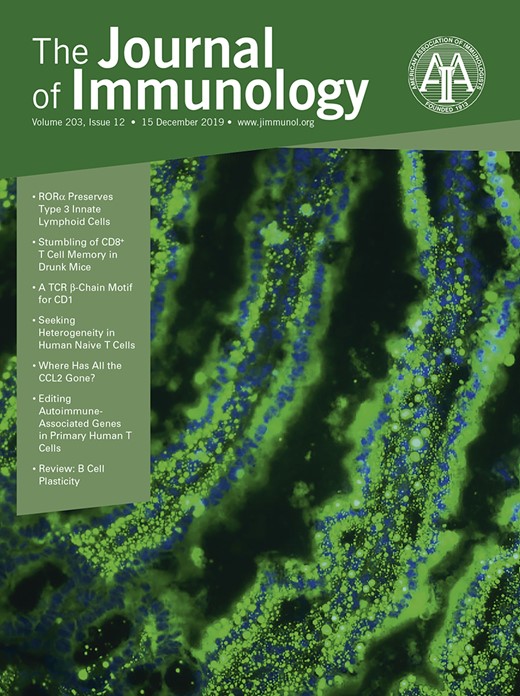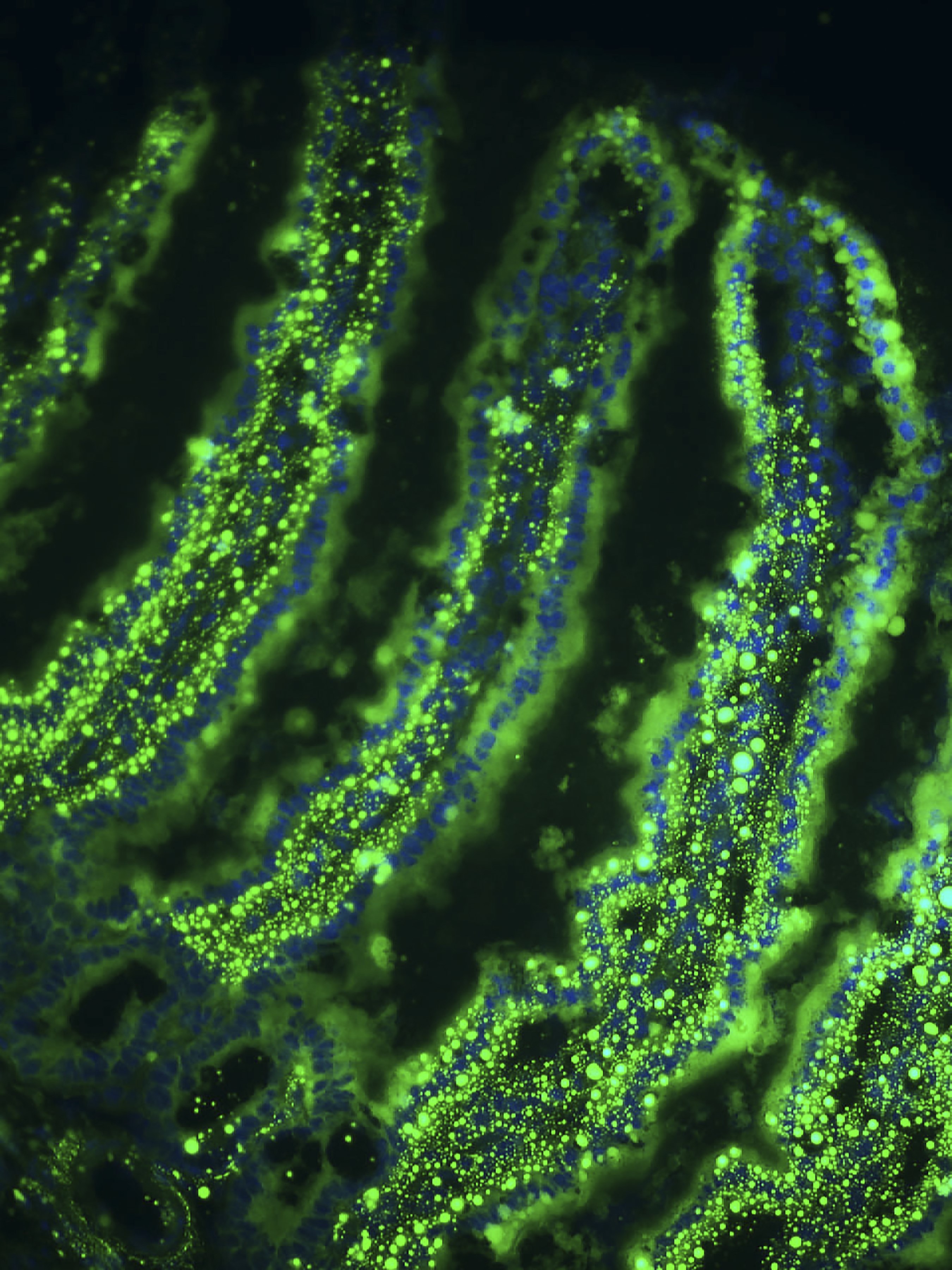
Cover image

On the cover: Representative image of a histologic small intestine section stained with DAPI (blue) and BODIPY FL dye (green) from mice fed a high-fat diet demonstrating an accumulation of lipid droplets in the villi within 14 wk of high-fat diet administration. Park, C., K. P. Cheung, N. Limon, A. Costanzo, C. Barba, N. Miranda, S. Gargas, A. M. F. Johnson, J. M. Olefsky, and J. M. Jameson. 2019. Obesity modulates intestinal intraepithelial T cell persistence, CD103 and CCR9 expression, and outcome in dextran sulfate sodium–induced colitis. J. Immunol. 203: 3427–3435.
Volume 203, Issue 12, December 2019
Top Reads
Top Reads
Letters to the Editor
Comment on “Cutting Edge: Role of MASP-3 in the Physiological Activation of Factor D of the Alternative Complement Pathway”
Response to Comment on “Cutting Edge: Role of MASP-3 in the Physiological Activation of Factor D of the Alternative Complement Pathway”
Comment on “IL-1β Induces the Rapid Secretion of the Antimicrobial Protein IL-26 from Th17 Cells”
Response to Comment on “IL-1β Induces the Rapid Secretion of the Antimicrobial Protein IL-26 from Th17 Cells”
Brief Reviews
The Plasticity of Newly Formed B Cells
Cutting Edge
Cutting Edge: Involvement of the Immunoreceptor CD300c2 on Alveolar Macrophages in Bleomycin-Induced Lung Fibrosis
CD300c2 exacerbates BLM-induced pulmonary fibrosis.
CD300c2 on alveolar macrophages enhances neutrophil recruitment.
CD300c2 amplifies HMGB-1–mediated TLR4 signaling.
Allergy and other Hypersensitivities
The Pglyrp1-Regulated Microbiome Enhances Experimental Allergic Asthma
Pglyrp1 enhances allergic asthma in mice through its effect on the intestinal microbiome.
This effect is strong in asthma-prone mice and weak in asthma-resistant outbred mice.
This effect requires germ-free mice before colonization with the Pglyrp1 microbiome.
Antigen Recognition and Responses
Functional Attributes of Antibodies, Effector Cells, and Target Cells Affecting NK Cell–Mediated Antibody-Dependent Cellular Cytotoxicity
IgG fucosylation status and target cell Ag density determine NK cell ADCC.
Aspecific serum IgG bound to FcγRIIIa and target cell glycocalyx limit NK cell ADCC.
NK cell FcγRIIIa is preferentially occupied by high-affinity afucosylated serum IgG.
Autoimmunity
Targeting the Immune Complex–Bound Complement C3d Ligand as a Novel Therapy for Lupus
Anti-C3d mAb 3d-8b blocks in vivo CR2-dependent Ab production to foreign Ags.
Anti-C3d mAb 3d-8b is capable of blocking in vivo iC3b/C3d from CR1/CR2.
Disruption of the B cell–CR2 costimulatory signal reduces autoantibody production.
Clinical and Human Immunology
TNF-Producing Th1 Cells Are Selectively Expanded in Liver Infiltrates of Patients with Autoimmune Hepatitis
TNF-producing CD4+ T cells in patients with AIH are significantly expanded.
Most TNF-producing T cells also produce IFN-γ and have an inflammatory phenotype.
Autoantigen-specific stimulation results in expansion of these inflammatory T cells.
CCR2-Mediated Uptake of Constitutively Produced CCL2: A Mechanism for Regulating Chemokine Levels in the Blood
Chemokine ligand CCL2 is cleared from the blood in a CCR2-dependent manner.
CCR2-dependent clearance of CCL2 is G protein (Gαi, Gαs, or Gαq/11) independent.
Equilibrium between secretion of CCL2 and its uptake by CCL2 determines blood levels.
Efficient CRISPR/Cas9 Disruption of Autoimmune-Associated Genes Reveals Key Signaling Programs in Primary Human T Cells
CRISPR gene disruption in CD4+ T cells is enhanced by donor DNA template delivery.
Disruption of key signaling proteins in human CD4+ T cells mimics murine data.
Hyperactive signaling in human T cells can drive compensatory regulatory responses.
CXCR3 Identifies Human Naive CD8+ T Cells with Enhanced Effector Differentiation Potential
CXCR3 identifies human naive CD8+ T cells with biased effector potential.
Human naive CD8+ T cell subsets are functionally and transcriptionally distinct.
Effector potential correlates with the physicochemical attributes of expressed TCRs.
Intermediate Monocytes in Acute Alcoholic Hepatitis Are Functionally Activated and Induce IL-17 Expression in CD4+ T Cells
Circulating intermediate monocytes are enriched in AH patients.
AH intermediate monocytes are functionally activated.
AH intermediate monocytes induce CD4+ T cell IL-17 and are enriched in the liver.
Immune Regulation
Invariant NKT Cells Functionally Link Microbiota-Induced Butyrate Production and Joint Inflammation
A high-fiber diet attenuates arthritis in a microbiota-dependent manner.
Butyrate attenuates arthritis in an iNKT cell–dependent manner.
Butyrate inhibits cytokine production of iNKT cells in an HDAC-dependent manner.
The Transcription Factor RORα Preserves ILC3 Lineage Identity and Function during Chronic Intestinal Infection
RORα deficiency leads to a reduction in ILC2 and ILC3 subsets during infection.
Residual Rorasg/sg ILC3s have lower expression of Rorc and lineage-specific receptors.
RORα conserves ILC3 function by modulating integration of environmental cues.
CD31 Acts as a Checkpoint Molecule and Is Modulated by FcγR-Mediated Signaling in Monocytes
FcγR activation in human monocytes regulates the localization and expression of CD31.
FcγR-mediated CD31 downregulation is mediated mainly through FcγRIIa and PI3K.
CD31 negatively regulates FcγR-mediated phagocytosis but not cytokine production.
OX40L-JAG1–Induced Expansion of Lineage-Stable Regulatory T Cells Involves Noncanonical NF-κB Signaling
OX40L-JAG1 induced Treg proliferation mediated via noncanonical NF-κB signaling.
OX40L-JAG1 expanded epigenetically stable and suppressive Tregs to ameliorate EAT.
OX40L-JAG1 induced TCR-independent selective proliferation of human thymic Tregs.
Neuropilin-1 Expression on CD4 T Cells Is Atherogenic and Facilitates T Cell Migration to the Aorta in Atherosclerosis
Western diet feeding increases Nrp1 on Foxp3− CD4 T cells in ApoE−/− mice.
Nrp1+Foxp3− CD4 T cells are highly proliferative and atherogenic.
Nrp1+Foxp3− CD4 T cells preferentially migrate to the aorta and PaLN.
Adenosine Receptor Signaling Targets Both PKA and Epac Pathways to Polarize Dendritic Cells to a Suppressive Phenotype
Adenosine targets both PKA and Epac pathways to suppress dendritic cell activation.
Adenosine/cAMP increases the expression of negative regulators of NF-κB signaling.
Immune System Development
miR-183-96-182 Cluster Is Involved in Invariant NKT Cell Development, Maturation, and Effector Function
miR-183C expression dynamically changes during iNKT cell development.
The deletion of miR-183C interferes with iNKT cell development and function.
Multiple target molecules are involved in miR-183C–mediated iNKT cell regulation.
Cross-Reactivity to Kynureninase Tolerizes B Cells That Express the HIV-1 Broadly Neutralizing Antibody 2F5
2F5 BCR B cells are tolerized primarily by reactivity to kynureninase, not lipid.
Extensive receptor editing occurs in 2F5 BCR knock-in mice.
Mature and anergic B cells often express identical BCRs in 2F5 knock-in mice.
Immunotherapy and Vaccines
Immune-Focusing Properties of Virus-like Particles Improve Protective IgA Responses
VLP enhances antinorovirus IgA recall responses in humanized mice.
Particulate structure is required for IgA enhancement.
VLP-driven IgA responses are functionally superior to IgG responses.
Early Protection against Pertussis Induced by Live Attenuated Bordetella pertussis BPZE1 Depends on TLR4
Live pertussis vaccine BPZE1 protects against B. pertussis infection within days.
Early protection induced by BPZE1 does not depend on adaptive immune responses.
Early protection induced by BPZE1 depends on TLR4-mediated innate immune responses.
Infectious Disease and Host Response
Pathogenic Role of an IL-23/γδT17/Neutrophil Axis in Coxsackievirus B3–Induced Pancreatitis
CVB3 infection induces a transient IL-17A expression in the pancreas of mice.
Pancreatic IL-17A is mainly produced by Vγ4γδ T cells.
IL-23/γδT17/neutrophil axis is critically involved in the onset of CVB3 pancreatitis.
Chronic Ethanol Consumption Reduces Existing CD8 T Cell Memory and Is Associated with Lesions in Protection against Secondary Influenza A Virus Infections
Chronic EtOH consumption alters the existing memory T cell compartment.
EtOH-induced changes in existing memory T cells increase susceptibility to IAV.
Chronic EtOH alters memory T cell–mediated killing and recruitment into the lungs.
Innate Immunity and Inflammation
STAT3 and STAT5 Signaling Thresholds Determine Distinct Regulation for Innate Receptor–Induced Inflammatory Cytokines, and STAT3/STAT5 Disease Variants Modulate These Outcomes
An IBD genetic risk variant increases expression of both STAT3 and STAT5 in MDMs.
Inflammatory cytokines increase once STAT3/STAT5 expression falls below a threshold.
Various STAT3/STAT5-dependent inhibitory cytokines cooperate to reduce inflammation.
Regulatory Role for NK Cells in a Mouse Model of Systemic Juvenile Idiopathic Arthritis
Mice with sJIA show aberrant NK cell phenotype and defective NK cell cytotoxicity.
NK cells have a regulatory role in the development of sJIA disease.
NK cell defects are associated with more activated monocytes and dendritic cells.
Staphylococcus aureus–Derived PSMα Peptides Activate Neutrophil FPR2 but Lack the Ability to Mediate β-Arrestin Recruitment and Chemotaxis
FPR2-specific PSMα peptides are not chemotactic but activate the NADPH oxidase.
PSMα peptides induce ERK1/2 phosphorylation but not β-arrestin recruitment.
IFN-Stimulated Genes in Zebrafish and Humans Define an Ancient Arsenal of Antiviral Immunity
We established an exhaustive list of larval zebrafish ISGs.
Orthologous ISGs in fish and humans identify a large ancestral ISG repertoire.
Binding of the Duck Tembusu Virus Protease to STING Is Mediated by NS2B and Is Crucial for STING Cleavage and for Impaired Induction of IFN-β
The cleavage determinants of duSTING by NS2B3 are the R84 and G85 residues.
The interaction region is essential for the cleavage of duSTING by NS2B3.
Molecular and Structural Immunology
Structural and Functional Basis for LILRB Immune Checkpoint Receptor Recognition of HLA-G Isoforms
The β2m-free HLA-G1 isoform tends to dimerize and further multimerize.
The β2m-free HLA-G1 isoform specifically binds to LILRB2 with avidity effects.
The crystal structure of LILRB1/HLA-G1 complex showed a flexible binding manner.
A TCR β-Chain Motif Biases toward Recognition of Human CD1 Proteins
TCR β variable gene 4-1 (TRBV4-1) is overrepresented among CD1b-specific T cells.
The association between TRBV4-1 usage and CD1b is independent of lipid Ag.
CD1b residue E80 is essential for binding of TRBV4-1–utilizing TCRs.
Mucosal Immunology
Activation of NLRX1 by NX-13 Alleviates Inflammatory Bowel Disease through Immunometabolic Mechanisms in CD4+ T Cells
NLRX1 activation induces immunometabolic mechanisms to reduce effector CD4+ T cells.
NX-13 is a novel NLRX1-targeting therapeutic for IBD.
NX-13 is effective in three mouse models of IBD and primary human cells from UC.
Macrophages Are a Potent Source of Streptococcus-Induced IFN-β
Bone marrow GM-CSF culture gives rise to four distinct populations.
GM-CSF MΦ can produce IFN-β.
GBS-stimulated GM-CSF MΦ have the ability to adapt their phenotype to be more DC like.
Obesity Modulates Intestinal Intraepithelial T Cell Persistence, CD103 and CCR9 Expression, and Outcome in Dextran Sulfate Sodium–Induced Colitis
Diet-induced obese mice exhibit reduced αβ and γδ IEL persistence within 7 wk.
Obese mice are more susceptible to dextran sulfate sodium–induced colitis.
Diet-induced weight loss restores IEL number and improves outcome in colitis.
Transplantation
A Novel Immunosuppressant, Luteolin, Modulates Alloimmunity and Suppresses Murine Allograft Rejection
Luteolin suppresses allograft rejection by regulating alloimmune responses.
Luteolin reduces effector T cell frequency while inducing CD4+Foxp3+ Tregs.
It also inhibits T cell proliferation by downregulating AKT/mTOR signaling.
Tumor Immunology
Exosomes Produced by Mesenchymal Stem Cells Drive Differentiation of Myeloid Cells into Immunosuppressive M2-Polarized Macrophages in Breast Cancer
Breast tumor MSC-derived exosomes elicit differentiation of M-MDSC to TAM.
MSC exosome–educated myeloid cells exacerbate immunosuppression in the breast TME.
In vivo PD-L1 blockade neutralizes MSC exosome–driven breast cancer progression.


